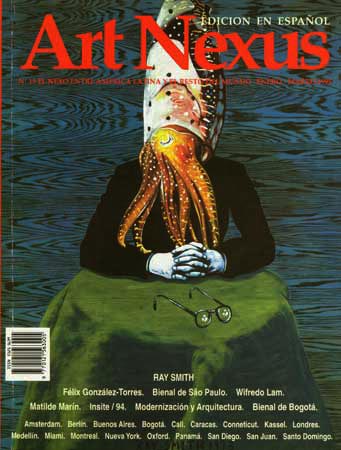Luis Camnitzer
January – March 1995
From: Camnitzer, Luis. “Memoria de la Postguerra,” Art Nexus, no. 15, Jan-March, Bogotá, Colombia,1995, p. 30.
Memoria de la Postguerra
by Luis Camnitzer
Under this title-dripping with fresh pain or blood -a new publication has appeared in Cuba. Half-way between an art journal and a newspaper- not in terms of its presentation, which is economic and textual, but at the conceptual level, Memoria is an unusual event in the cultural life of Cuba of the last decade, with an outstanding presentation at the recent fifth edition of the Havana Biennial, is the creator and director of the publication, the first issue of which was distributed at her installation at the Biennial. The publication is self-financed and gathers together ideas by artist and critics who want to express their views. Neither of these features suffices to describe the journal. What is noteworthy is the fact that at a time of unprecedented economic crisis in which distances have grown almost ad infinitum due to the lack of transport and the international dispersion of artist, Memoria has not only assembled ideas but has helped maintain a sense of coherence.
The publication appears at a time in which Cuban art is running the risk of losing the cultural coherence the previous decade. With the goal of providing guaranteed employment for artist and attracting tourism to bring in foreign currency, Cuban artist have become part of a market which is increasing by similar to the Western market. Dialogue with the Cuban people (and between artists themselves) is threatened with replacement by competition, and the former cohesion is being loosened by migrations due to the economic factors. Memoria evidences the intense outside activities carried out by our colleagues over the last three years with a list of 105 artist who have emigrated; a very small fraction of them have used political exile as the reason for their departure.
In this departed, Memoria acts as a magnet for ideas. It is, over and above the gossip and correspondence, a primary vehicle for communication. The texts, sometimes cloistered within a vernacular hermeticism, other times of a clearly humoristic nature, resume the path of sane demystification established by the las generation of artists from the 1980s. Lazaro Saavedra, a member of that generation, describes his new work (in a text from the 1990:) the clay vessel, copied from a native design and thus genuinely national, will have a popular impact, and will bring art to the masses., since it will be mass produced , and thus solve its own financial problems. At the same time, sinceit will also be sold to foreigners, currency will flow into Cuba, and the work will be a vehicle for our ideology which will threaten the repulsive capitalist system>. Meanwhile, Kcho (Alexis Leiva) reproduces the form on which his application for a visa to United States was refused, which begins with the words: <You have been denied a non-immigrant visa under section 214(b) of the United States Immigration and Naturalization Act. Under this Act, an applicant for a non-immigrant visa is considered an immigrant>. Alejandro Lopez analyzes in detail the use of time in artistic creation, 0.9 per cent, which he promises to reduce even further for the Day of Cuban Culture. He explains that <I want in this way to show my comrades that despite the difficulties we face, it is still possible and even necessary to do less art…>.
Memoria brings together the artists who have remained in Cuba and those who left recently. While the separation from the <moles> is preserved and becomes less marked in the case of the <Marielitos>, there seems to be no separation from those who have only recently left. The diaspora is more an expansion than a break and Memoria is one of the spontaneous instruments which helps promote cohesion. The second issue deals almost entirely with exile and the diaspora, as seen from the island and from the outside, both historically and poetically. One of the serious notes (by Lazara Castellanos) recalls Angel Acosta Leon with the subtitle Suicide is the continuation of exile.
Over and above all this, Memoria may well be a new spearhead of Cuban art -a new proposal which brings together the writer and the visual artist in their dommon concerns, where the visual artist joins to form a hybrid with the writer and discovers and voice which is equally eloquent with words as imagesimages.
In the meantime, Memoria is also a free enterprise satire, not only because of the fact of its actual appearance, but because of the devices applied to self-mythification. The publication not only adopts the traditional format of editorial, letters, and sections (which lose their meaning when the titles are read), but includes advertisements offering non-existent services (<photocopies of passport documents>) or space for publications on unrelated issues. Bruguera goes around with little gifts with the publication’s logo (ashtrays, key rings, pen holders, etc.) for potential contributors.
Memoria de la postguerra, in its first two issues, has become an essential source of documentation for anyone wishing to learn about Cuban culture at these critical times on the island. Thanks to this little publication, the diagnosis of the country’s health is good, despite the enormous lack of material resources.
Unfortunately, rumors are circulating that the publication does not have the approval of Cuban bureaucracy. It would be very unfortunate if, at such a time of economic crisis, which so seriously affect the scope for creative work by Cuban artists, this alternative journal should cease to exist. Memoria is one of the necessary vehicles, which an entire generation of artists need if they are to maintain their cultural coherence and mental health throughout this period of anxiety.
